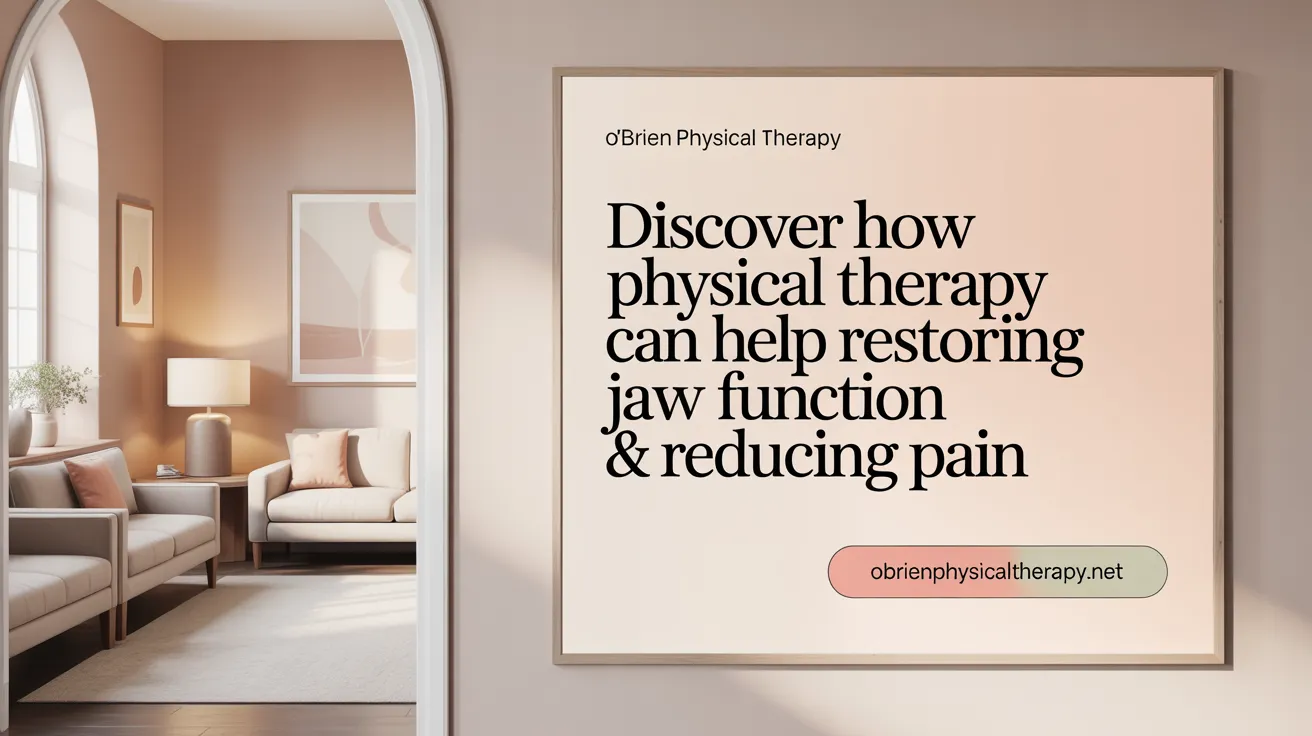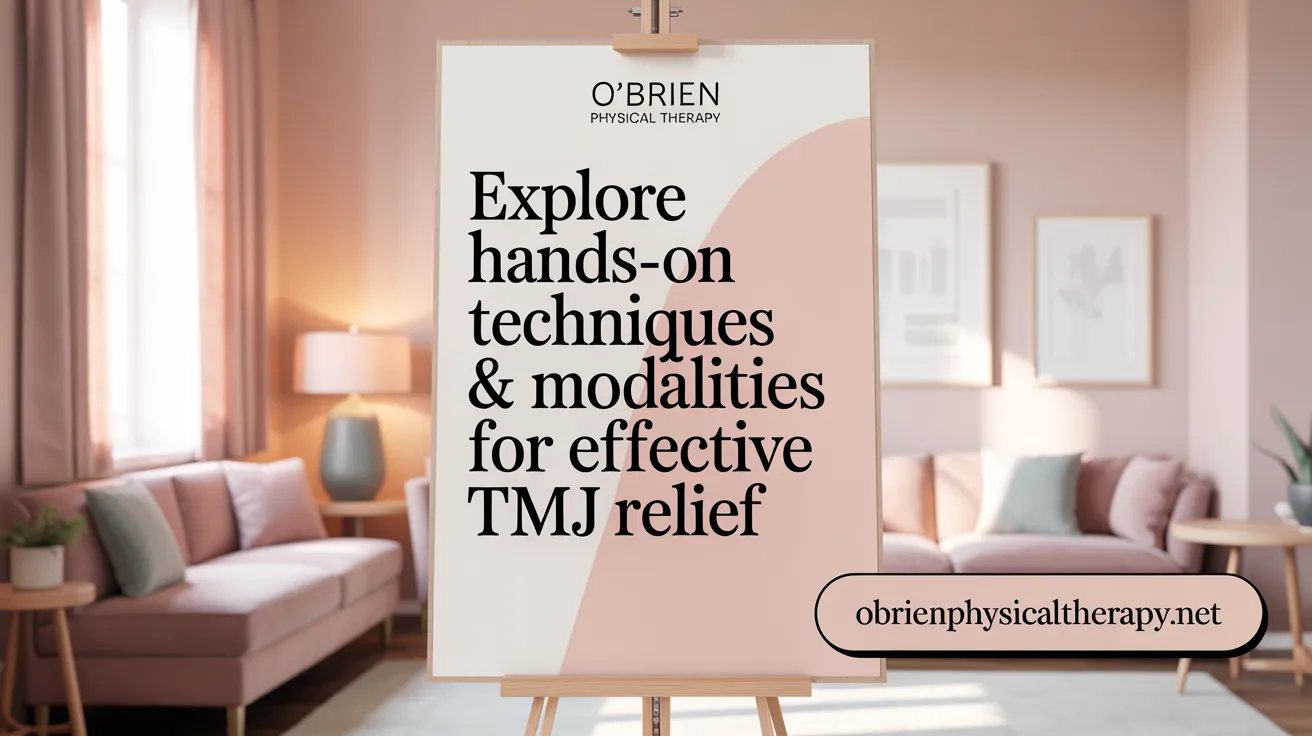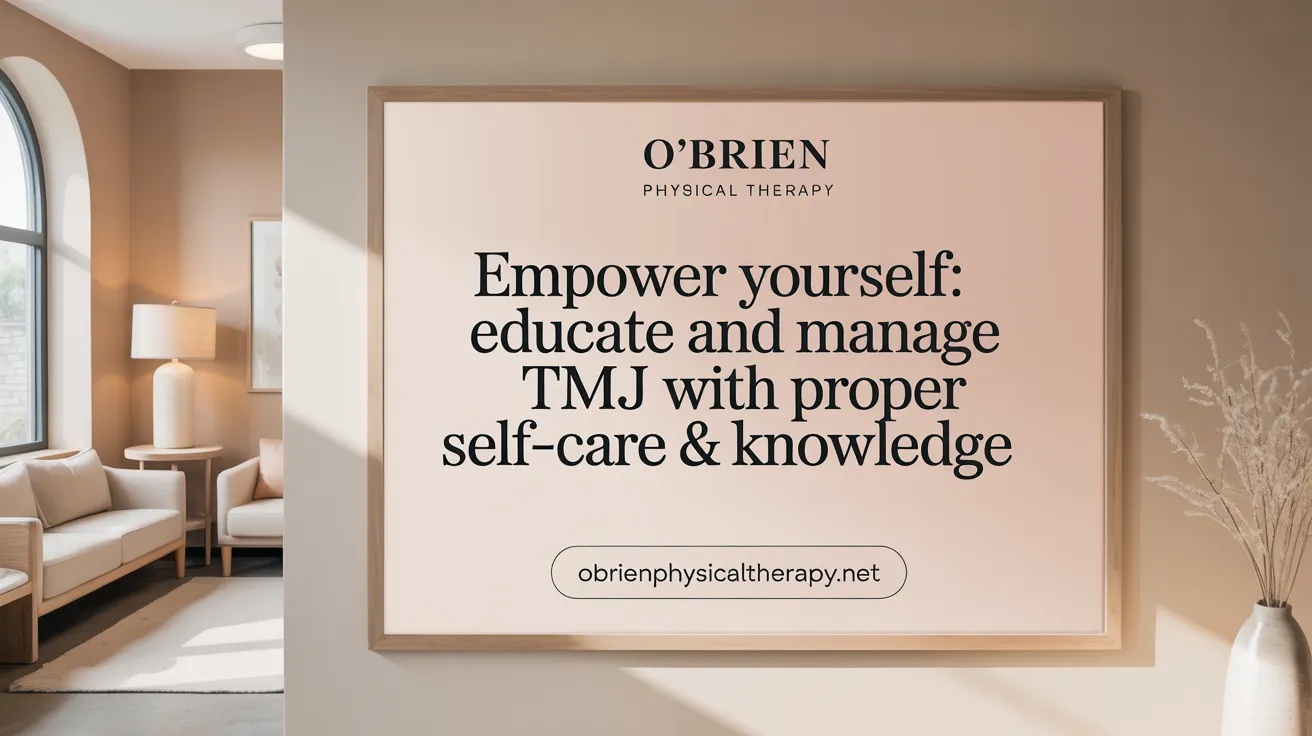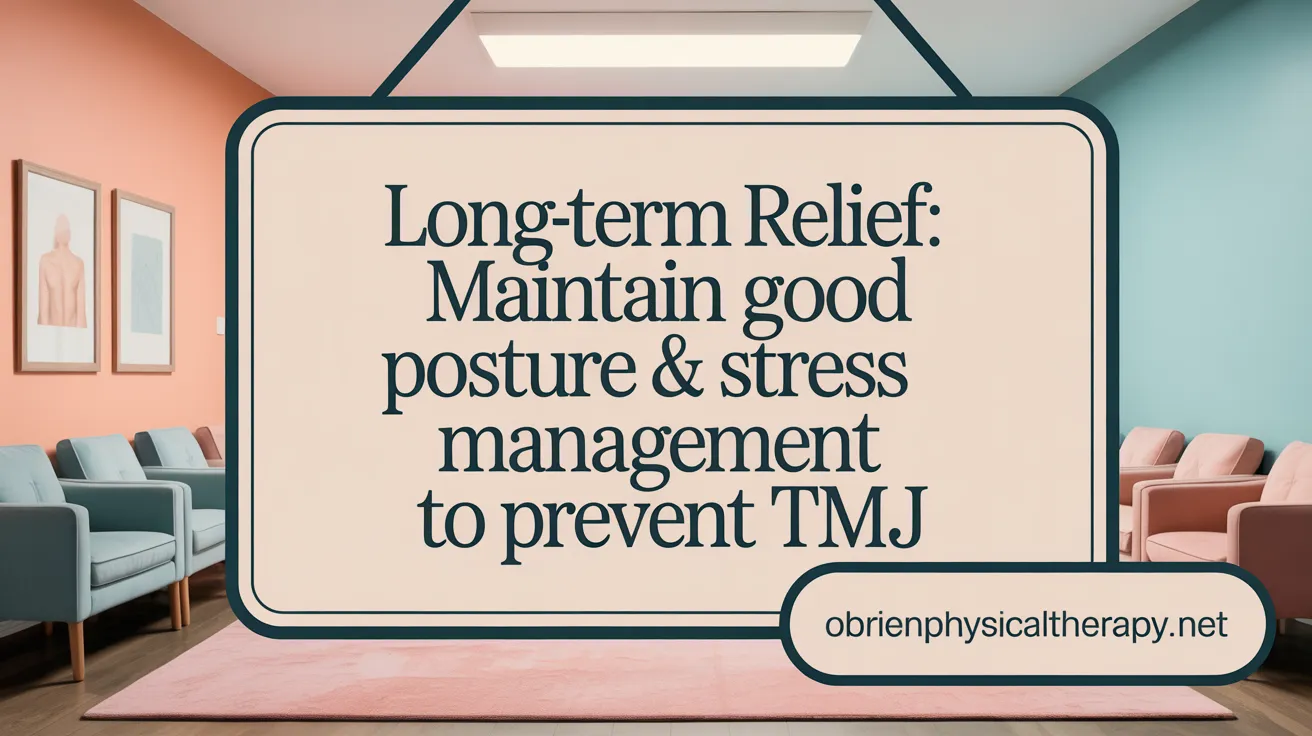Understanding TMJ Dysfunction and Its Impact
Temporomandibular joint (TMJ) dysfunction is a prevalent condition that affects the jaw joint and surrounding muscles, causing significant pain and limiting daily activities such as speaking and eating. This condition stems from a combination of factors including muscle tension, joint inflammation, and structural issues. Physical therapy has emerged as a powerful, non-invasive treatment option that not only addresses symptoms but also tackles underlying causes to restore jaw function and improve quality of life. This article explores how physical therapy aids in managing TMJ dysfunction, the techniques involved, and the benefits it offers compared to other treatments.
<!-- VIDEO:eyJsaW5rIjoiaHR0cHM6Ly93d3cueW91dHViZS5jb20vd2F0Y2g/dj15VHZZSUJKZjRqcyIsImltYWdlVXJsIjoiZGF0YTppbWFnZS9qcGVnO2Jhc2U2NCwvOWovNEFBUVNrWkpSZ0FCQVFBQUFRQUJBQUQvMndDRUFBa0dCd2dIQmdrSUJ3Z0tDZ2tMRFJZUERRd01EUnNVRlJBV0lCMGlJaUFkSHg4a0tEUXNKQ1l4Sng4ZkxUMHRNVFUzT2pvNkl5cy9SRDg0UXpRNU9qY0JDZ29LRFF3TkdnOFBHamNsSHlVM056YzNOemMzTnpjM056YzNOemMzTnpjM056YzNOemMzTnpjM056YzNOemMzTnpjM056YzNOemMzTnpjM056YzNOLy9BQUJFSUFGTUFsQU1CSWdBQ0VRRURFUUgveEFBY0FBQUFCd0VCQUFBQUFBQUFBQUFBQUFBQUFnTUVCUVlIQVFqL3hBQkZFQUFDQVFNQ0F3UUdCQXNGQ1FBQUFBQUJBZ01BQkJFRklRWVNNUWNUUVZFaVlYR0JrYk1VTXFHeEZSY2pOa0pTYzNYQjBkSlRZblNqc2dnV016ZEZWZFB3OGYvRUFCa0JBQUlEQVFBQUFBQUFBQUFBQUFBQUFBQUJBZ01FQmYvRUFDSVJBQUlDQWdJQ0F3RUJBQUFBQUFBQUFBQUJBaEVESVJJeEJFRVRNbEZoQmYvYUFBd0RBUUFDRVFNUkFEOEF5UEMwQ09ZZXlqdXZTaUJjTmlwQ093d1RUeThsdkMwaHo0RFllMnBjOE9haTZCd25JZlUyMVdQUmJKTGExUkF2VGQyOHo0MU9SSUd4bGR2TEZaSjVuZWpkRHgxV3pPem9tcVJITHhjK09uS2FhM1NUMjc4c3FFZTBkSzFLU0JXR0ZVWjlsUU92NmFrMEpabEI1ZXBwUnpOOWhMQWt0RkNXNUtuMGx5QlR4WkZrSE1tTVUwdVY1R0l3QnlrallVVzJsNVppUEIvRDExb2pJeVNWRGhobGlhTkd4VTcxcm5DZlpScFd1Y042ZnFrK28zOGN0MUNKR1NNcHlxZlZsYzFMZmlSMFgvdTJwLzVmOU5UNUE0cGV6RG1ldUE1cmNmeEk2SWYrcmFsL2wvMDFTK0VlQnJIWE9MdGMwVzR1N3FPSFQyY1J5Ujh2TTJINWQ4akhTamtIQzkyVUE0elJsR2EwM3RCN0w3Ymh6aDk5VTB1OHU3a3d5TDM2emNwd2gyeU1BZENSN3MxbUdlVUZzN0NpeE9JcDBORmRqbmF0bjBmc1pzYmpTclNiVTlRdm9ieVNKV21pajVPVkdJeVZHVjhPbFpqeGxwRU9nY1RYK2xXMGtrc1ZzNnFyeVk1amxGYmZHMzZWRmc0LzBpTW5rb3E1RlRIQitsUmEvd0FUYWZwTnhMSkhGY3V5dThlT1lBSXpiWjlsYVpydlpCcEdtYUpxR29SYW5xRHlXdHRKTXF2M2VDVlVrQStqMDJvYkdvMlkwd2JOQ2h6WjZtaFRLMjZFT2JOTFdVYnpYY1N4cHp0ekFoZlBGTk9id3Avb3JTTHFFZmNieUVNQjhEVVpkRTQ5b3Z1bVhQZjIvZHVnU2NiRlIvQ2kzTVU2UzgwK29QYnArcW5sVFhoaTFmNlgza29ZU3g1eWNqQkI4Q01kYWs5ZHNXdTR3UXFuekpyRTZUT2lyY1Jlejd4b3o5R3VsdVFCOVdRWVlEMVYyNmg3K0JsSUtsaFNHbldVaUxhOTJ3QmhYbExCZnIrMnBhZFBSL3ZWR1RSS0NiN01sMUtBeFN5SXczRlJ5cGhndzhEdlY0bDRmbjFIVTdoWlB5VVNuSmtQVEZOdUxPSExiU3JhM3ViVm42cUhWam5PUWY0aXRFSnJveXp4U3B5SE9sOW9mRXVsYWZCWVdGK3NkdGJweVJwM0NIQTlwRmVodUdicWErNGIwcTh1VzVwN2l5aGxrWURHV1pBU2NlMDE1S0RkY1Y2djRML003UXYzYmIvTFdyeWk3anN5VGpydEM0bTBqaS9WTlBzTDVJN2FDVUxHaGdRNEhJcDZrZVpwZnNNdTVyN2k3V3J1NVlOUFBiOTVJd0dNc1pBU2NWVHUxRTQ3UU5iL0FHeS9MV3JUL3MvSFBFT3Avd0NESCtzVWh0OW8yM1ViT0RVYkM1c3JwZWFDNGlhS1JUNHFSZzE1NjRJNFF1SnUwYjhEMzBlWTlNbWFXNUpHektoSEw3bUpUYnlKcmVOVTFpUFR0VzBxem13RTFCNUlsYnljTHpMOGNFZTNGTFE2WFpXdXAzbXFSb3FYTjFIR2s3azlRbWNmZjlnOHFCSjB0ajhDdk1mYXV4WHRGMXI5cEg4cEs5RjhQYXBIcldrUWFsQVB5TndXYVAxcHpFS2ZlQURYbkx0WngrTVRXZ2Y3U1A1U1UvYUZWSm9OMldZUGFEb21PdmV2OHQ2OUI4YWJjSGE3KzdyajViVjU0N0tXejJpYUtCL2F2OHQ2OUQ4YS9tYnIzN3V1UGx0U0pSN2llVE9laFNkQ3BFQXJjdm5tcGZoUmsvQ3VDTis3Ymw5dTFRdWMwOTBqdlk5UnQzaVVsdy9RZVhqVVpkTWNIVWthYnAxeEJGYnlSeHF6M0tra3hnTHpIMlpJRk8wa2RvZ1pJM1FBQWtQam1YejZFZzFBcEtJYnh1L0t4aVhETEl4SUhUYmNBMDZ1dUpkT3MzRWNranN4MnpHak1QdXJGeGJPb3BwTFphTGZ1MWlVSmc1R2FRdXpnNXBwcDk1RExDSGhibWlPQ2g5Ui93RFRTZDllNUJWQVMzcUdhaDdKNjdGSUNBSTJWUTJKaUdIVFB0TlVuajNVUTF4RFlRdGxJZDVNYmptM3dQZGsvR3JSb3hra3M3aU5tNVdhUm1RbmFzMjFqdlB3bGNMTUNKRWtJWUgyMWRnVnpNdmtUcUZmb2l1Y1pyMWx3WCtaMmhmdTIzK1d0ZVMrK0d5NVVlMDRyZCtITzF6aFRUdUh0THNiaWE2NysyczRvWkFzR1J6S2dCd2M3N2l0Yk1TM0ZtYWRxZjhBekMxdjlzdnkxcTNmN1B5S05kMUZnMlNiVEJIbDZZcWc4Y2F4YWEzeGJxZXAyTE1iYTRrVm8rY2Nwd0VVYmozR3B2c200dTBqaFBWNzY1MWVTUlk1cmNScjNTY3g1dVlHbDZIN1pvSGIvUExhNmJvZHhiT1k1NHIweVJ1UDBXVmNnL0VWRThWZHNObHFYQ2QxWWFmYVhrR3BYVUFpWjNWZTdUbTJmQkRaNmN3RzNsVVQydWNlYUh4WnB1bnc2UEpNejI4N1BKM3NmTHNWeHRXWE5OR1I5WWZHaWh1VlVqMVQyV25QWjlvZitHL2lheFR0SjA2KzFUdE0xeURUYlNlN21VbzVpZ1F1M0tJbzhuQTlvcTVjRDlxdkMraWNKYVpwdDdMY2k0dG9lU1FKRGtaeWVoelVEby9IbWcyM2F4cW5FYzg4cTZkZFFkM0czZGt0bmxqRzZqY2ZVTklkYmRnN0l1RHRiVGpLMDFLKzB5N3M3U3pEdXozTUpqNW1LbFFvRFlKNjU5MWJGMmczQ1d2QSt1eVNNQURZeW9NK2JLVkgya1ZYNU8yTGdwVnl1b3pPZjFWdFpNL2FCV1k5cFhhZi92WmFycG1sd1NXMm04NGVReWtkNU1SMEJBSkFBTytNbk8zbFRJOU5QOE02elFvWkhsWEtsWlMxWkxhZG9Xb1hjSWxSWTQwYmRlOXlDM3NHT2xXSGh6UlhzRE5jWGlHVzR3VlZZeG5DK1B2SnF6U21PMHNRODhld1VIR05zZVhxb3RtMXBkVzBGOWJqTU1qRVlKSTZBL0Rlc2tzc3BhT2xIeDR4cGxmdExxWXdLbW9XeGh1WVpOMGNkVUp5cCs4ZTZqVDZmMzErVGJwemp1MUFZallkY21sZGZWNHRRczdsMjlGNGdzbnFKM1UvWjk5U1ZnakJPY0ZCemV1bGE3TFk5VXdsdUJHa3Nha3JEYm9vYmw2c2NtcDdUNFk0WW1DZ1paZGlQR3FmZDMzMGU5YXpYbFpKeUMvbUNOeFYyaEFOc2poc2pGVlNDd3NuSXhqRWdCQ3Q4S29QSG1td3hvbXBJd1dWNUJHeWZyREdRZmRpcnhKSURrK3VxbnhWZG9zVWNMUmh6TnpZRERJQUcyYWxpYlV0Q2xqK1JjVVZYU2VJTlYwZ04rRGRRa2dEWXlvVldYYjFNQ0I3cWs1T091SnJtTHU1OVRpZVBQMVhzYmNqNGQzVVc5ckMvd0JST1VrZFFhYXZaeUtkaUc5WFN0MW95WlBGeXczVmtxT0p0VUJ6OUt0Q2YzYmJmK09uZHR4NXhGWjhvdHIrSlZDOG9RV01BVUQxQUpWWVpXVWtFRUVlQnJ1SElDRURicFRNeFlKK1B1SjVIN3h0VUFjZEN0ckFwQThzaE9sSC9HTHhjMmM2eTI0d1Q5R2h6L29xc05IZzdzSzRxSEdReTdVQVdWK1BlTEhPVzFxWTQzLzRVZjhBVFRXVGl6aUtVNWsxZTVieXlSdDdOcWlGQTZsVzlvcnBZQWZXSkhrYUFKUnVMTmZHRCtGSmdSNGdMbjdxajczV3RSdjlyeTdlVWYzZ052Z0tadVFUMW92TG5vUlFCM21ydGNLa2VLL0d1MEFiTnJoRTlqSWkvcEtRS2hMZUthR3lpdFk0aWthQWN3SG40bW5sMWVpS0VtWWQyZzZzVHRWZTFYaXMzQ2QzWWh1WS9wRVlBOTFZSXhiWjJxVDBoSGlpOE1nN252QTF3MnpBZEkxSFFWRnc2enFOckVrSXVCSXZUZGR3UGJUY0k3a3RJeEpZNUpORW1URzQ4SzB4Z2txRDRkMlQ4Q3B5ZlNBZWRuR2VZOWF2V2pYeVRXY1dHQkdNWTlZNjFrZk93WEhNMlBMTzFYRGdDNEhjM2NMbkpWZzR6Ni8vQUpWVThkS3lFc2JpckxOcXF5eGhwWWw5QngxOGo0R3M2dkxxVzl2V1o5dVVjaXFUc29GYWFTWnJSa09XSFFqUGhXYjZ6YlBhWDdyakNzUzM4NldLdVZGbUd1UWxrS09udjg2R01qZjdhSW96ak5ka09GSXp0NDRyUWFtY2tWWjF3dzNBd0g4Ui9Pa1hzSStYS1NrT09wZm9mNVV1dUVBTDVMbm9QS2pvcnY2VHI2QTZZcDJ5bWZqWTU3YTJRYzhUUlNGSEJEZVZGWGFwaS90eFBDWC9BRTAzQjh4NGlveEhWVndWQi9oVWs3T1Bud3ZGT2d2TzNUSnJoYlBoUXp2UmdRbzZVeWdiSHJRb3pFRW5hbExTM2E1bkVhbFY5Rm1abUp3cXFDeEp3Q2RnRDBCTkFDT0tGVGx6d3Jxc003d3h3QzRLWURtTmdPVWtBNFBOamZCQjloRkNnQ2Q0NWtjQzBpRFlSaVNSNTFYTFlEdXljYjVvVUtveC9VN21FY1kzcE9RQUwwb1VLbVhvYk45V3JCd014R3FUQUhZeGIvR3UwS2prK3BUbDZML0R0SExqMTFVdU5VVUlyQWI3SE5DaFdXSDNLbzlvcmNaOUVVUitzUThNRSsraFFyWWJHS29xODRHUENqOG9KeWMvR2hRb0pvT20vWHlOVjRqSFR5b1VLbEU1UCtoM0U2dTVOZFAxYTdRcVJ6aHUxT2RPZG9yMkJreGt1RU9RQ0NyZWl3SVBtQ1JYYUZNQ2Q0bHZyeXcxeTZ0clM3dUk0azVjZmxXSlBvZzVaaWNzZkRKSjJBSFFBVUtGQ2tNLy85az0iLCJ0aXRsZSI6Ik1hbmFnZW1lbnQgJiBFeGVyY2lzZXMgZm9yIFRlbXBvcm9tYW5kaWJ1bGFyIEpvaW50IChUTUogLi4uIiwic25pcHBldCI6Ik1hbmFnZW1lbnQgJiBFeGVyY2lzZXMgZm9yIFRlbXBvcm9tYW5kaWJ1bGFyIEpvaW50IChUTUopIERpc29yZGVyL1BhaW4gfCBQaHlzaWNhbCBUaGVyYXB5IHwgUmVoYWIgLi4uIFRNSiBFeGVyY2lzZXMgIzEgLS0tIEphdyBQYWluIEhlbHAgLS0tIFRlZXRoIC4uLiJ9 -->Causes and Symptoms of TMJ Disorders

What are the causes and symptoms of TMJ disorders?
TMJ disorders are linked to various factors that can affect jaw function and comfort. Common causes include jaw injuries, arthritis such as rheumatoid or osteoarthritis, muscle spasms, and habitual behaviors like teeth grinding (bruxism). Malocclusion, or misalignment of the teeth, can also contribute, alongside other issues like cartilage displacement, ligament strains, autoimmune conditions, and trauma.
Symptoms of TMJ dysfunction often manifest as jaw pain or tenderness, which may be accompanied by headaches, neck, and shoulder discomfort. Many people experience clicking or popping sounds when moving the jaw, along with stiffness and limited ability to open or close the mouth. Ear-related symptoms like ringing (tinnitus), dizziness, or facial pain can occur as well.
Individuals might notice changes in bite alignment or frequent muscle tightness and spasms around the jaw area. The severity and persistence of these symptoms vary from person to person. Diagnosing TMJ disorders typically involves physical examination, assessment of jaw movement, and imaging tests such as MRI or X-rays.
Treatment strategies are diverse, ranging from lifestyle modifications and medication to targeted physical therapy. In some cases, surgical intervention might be recommended, especially when conservative measures do not alleviate symptoms.
| Causes | Symptoms | Diagnostic Methods |
|---|---|---|
| Jaw injuries | Jaw pain or tenderness | Physical exam |
| Arthritis (rheumatoid, osteoarthritis) | Headaches, ear pain | Imaging tests (MRI, X-ray) |
| Muscle spasms | Clicking/popping jaw sounds | Patient history and clinical assessment |
| Teeth grinding (bruxism) | Limited jaw movement | Observation of habits and symptoms |
| Malocclusion | Dizziness, facial pain | Special tests for joint function |
| Ligament strains | Changes in bite, muscle tightness | Lab tests for autoimmune conditions |
Understanding the causes and recognizing the symptoms of TMJ disorders are crucial steps towards effective management. Consulting healthcare professionals helps tailor appropriate treatments, including physical therapy, which can significantly reduce discomfort and restore normal jaw function.
Overview of Physical Therapy for TMJ Dysfunction
How does physical therapy help with TMJ dysfunction?
Physical therapy plays a significant role in managing TMJ dysfunction by targeting pain relief and muscle tension reduction. Therapists utilize manual therapy techniques such as soft tissue work and joint mobilization to loosen tight muscles and realign the jaw joint. Customized exercises are crucial; these include jaw-specific movements like chin tucks, tongue lifts, and controlled opening and closing, all designed to restore normal jaw function and reduce inflammation.
In addition to direct treatments, physical therapists provide education on posture correction, body mechanics, and habits that may aggravate TMJ symptoms. For example, they advise avoiding excessive gum chewing or nail biting. Relaxation and stress management techniques, such as deep breathing, meditation, and mindfulness, are also recommended to decrease muscle hyperactivity that can worsen TMJ issues.
Therapists may incorporate modalities like heat or ice to relax muscles or reduce swelling, and ultrasound to improve joint mobility. Other advanced interventions include dry needling, which stimulates blood flow and diminishes pain, and massage therapy to relax facial, neck, and shoulder muscles.
Overall, physical therapy adopts an evidence-based, conservative approach tailored to each individual's needs. It aims not only to relieve pain but also to restore proper jaw movement, address muscle spasms, and improve overall quality of life. Recent research confirms that such holistic, non-invasive strategies can be highly effective, even in long-standing TMJ cases, often leading to significant improvements within weeks.
Physical Therapy Techniques and Exercises Effective for TMJ Relief
What physical therapy techniques and exercises are effective for TMJ relief?
Physical therapy offers a range of effective approaches to alleviate pain and improve function in individuals suffering from temporomandibular joint (TMJ) disorders. Central to these interventions are manual therapy techniques such as joint mobilization and soft tissue massage. These hands-on methods help decrease muscle tension, improve joint mobility, and relieve stiffness in the jaw, face, neck, and shoulder muscles.
In addition to manual treatments, specific exercises are designed to target the jaw directly. Exercises like chin tucks, resisted mouth opening and closing, side-to-side jaw movements, and forward jaw stretches help strengthen muscles and restore normal, pain-free movement. These movements can be tailored to the patient's needs, gradually increasing range of motion and reducing inflammation.
Posture plays a significant role in TMJ health. Physical therapists educate patients on maintaining proper head and neck alignment to reduce undue stress on the jaw joint. Correcting forward head posture and rounded shoulders can decrease muscle strain, which often exacerbates TMJ symptoms.
Modalities such as heat, ice, therapeutic ultrasound, and electrical stimulation (TENS) are frequently incorporated to manage pain and promote healing. Applying warm packs relaxes jaw muscles, while cold packs reduce inflammation and swelling.
A comprehensive treatment plan may also include self-care practices. These include applying heat or cold, eating soft foods to minimize jaw strain, avoiding habits like nail biting and gum chewing, and practicing relaxation techniques such as deep breathing or mindfulness to reduce muscle tension.
Physical therapists tailor these interventions based on individual assessments, ensuring a combination of exercises, manual treatments, and education effectively restores jaw function and alleviates symptoms. Early intervention and consistent self-management significantly contribute to successful outcomes in TMJ disorder treatment.
Comprehensive Treatment Options and Benefits of Physical Therapy for TMJ

What are the treatment options available for TMJ disorders and the benefits of physical therapy compared to other treatments?
TMJ disorders can be managed through various methods, including medications, oral splints, stress management, and lifestyle changes. Physical therapy stands out as a non-invasive approach that offers significant benefits.
Physical therapy offers tailored exercises, manual techniques, and postural adjustments to reduce muscle tension, improve joint mobility, and restore proper jaw function. Techniques like joint mobilizations, massage, dry needling, and heat or cold applications target muscular and joint issues effectively.
Unlike more invasive treatments such as surgery, physical therapy emphasizes conservative care that addresses the root causes of TMJ dysfunction.
A notable advantage is the inclusion of stress management strategies like relaxation techniques, which help decrease muscle hyperactivity. Education on habits like clenching, nail-biting, or gum chewing further supports symptom relief.
Physical therapy often complements other treatments, providing a comprehensive, long-term management plan. It can be used effectively as a first-line treatment and may reduce the need for medications or surgical intervention.
Benefits of physical therapy including pain relief and improved mobility
Patients undergoing physical therapy experience notable pain reduction, often within a few weeks. Techniques such as soft tissue release, joint mobilization, and targeted exercises help loosen tight muscles, decrease spasms, and alleviate discomfort.
Exercise programs, like the Rocabado 6x6, focus on restoring jaw coordination, muscle strength, and range of motion. Modalities like ultrasound, massage, and laser therapy further enhance tissue healing and relaxation.
Enhanced jaw mobility alleviates functional limitations, allowing patients to speak, eat, and perform daily activities more comfortably. Many patients report improvements in posture and reduction in neck and shoulder tension, which are often linked to TMJ symptoms.
Non-invasive and long-term management advantages
Physical therapy offers a conservative, low-risk alternative to surgical procedures. The techniques can be customized to each patient’s severity and specific needs.
Long-term management includes education on posture correction, stress reduction, and habit modification, empowering patients to maintain improvements independently.
Supporting strategies such as soft food diets, ice or heat application, and relaxation exercises complement in-office treatments.
Systematic reviews support the effectiveness of manual therapy and upper cervical mobilization, emphasizing their role in symptom control and improved mouth opening.
By focusing on muscle balance, joint function, and postural improvements, physical therapy provides sustainable relief, helping prevent recurrence and worsening of TMJ symptoms.
Manual Therapy and Modalities Used in TMJ Physical Therapy

Joint mobilization and soft tissue releases
In TMJ physical therapy, manual techniques like joint mobilization play a crucial role. These involve skilled hands-on treatments to gently move the jaw joint, helping to realign displaced discs and improve overall movement. Soft tissue releases target muscles such as the masseter, temporalis, and pterygoids. These techniques help reduce muscle tightness and alleviate pain, promoting better jaw function.
Laser therapy and therapeutic ultrasound
Laser therapy utilizes focused light energy that penetrates tissues, promoting healing, increasing blood flow, and reducing inflammation. Therapeutic ultrasound sends ultrasonic waves into tissues, which helps loosen tight muscles, relieve joint pain, and improve mobility. When combined with other exercises, these modalities enhance recovery and reduce discomfort in TMJ disorders.
Massage therapy and dry needling
Massage therapy around the jaw, face, neck, and shoulders relaxes muscles, decreases tension, and enhances circulation. This reduces inflammation and muscle spasms linked to TMJ dysfunction. Dry needling involves inserting fine needles into specific muscles to stimulate blood flow, lessen inflammation, and decrease pain, providing quick relief and promoting healing.
Heat and ice applications
Applying heat, such as warm packs, helps relax jaw muscles, reduce spasms, and ease stiffness, especially in the morning or after activity. Ice packs are effective for acute pain or swelling, helping to decrease inflammation and numb area discomfort. These simple modalities can be used alongside other treatments to support tissue healing and pain management.
Exercise Programs and Stress Management Techniques in TMJ Care
What Are Some Specific Exercises Used in TMJ Physical Therapy?
Physical therapists often utilize targeted exercises to restore jaw function and reduce pain. A popular set is the Rocabado 6x6 program, which involves six movements repeated six times to address TMJ dysfunction. These movements include tongue positioning, shoulder posture correction, head stabilization, neck extension, control of TMJ rotation, and rhythmic stabilization.
Other effective exercises include chin tucks, which help strengthen neck muscles; tongue lifts aimed at proper tongue placement; jaw side-to-side slides to increase mobility; and resisted mouth opening and closing exercises that strengthen jaw muscles. These routines are designed to improve joint stability, reduce inflammation, and promote pain-free movement.
How Can Postural Control and Stabilization Help?
Poor posture, especially forward head tilt and rounded shoulders, can stress the jaw joint and exacerbate symptoms. Postural control exercises focus on correcting these issues, promoting better alignment of the head, neck, and shoulders.
Physical therapists use activities like sitting upright with proper head alignment and scapular stability exercises. These help reduce muscle tension and alleviate strain on the TMJ, contributing to symptom relief and improved function.
What Relaxation Techniques Are Recommended?
Managing stress is crucial in TMJ treatment. Deep breathing exercises, mindfulness, and meditation help relax tense muscles and decrease muscle hyperactivity. Techniques like progressive muscle relaxation or guided visualization can reduce jaw clenching and grinding, common aggravators of TMJ issues.
Incorporating these practices into daily routines can significantly decrease muscle tension around the jaw and neck, supporting the physical therapy efforts.
What Lifestyle and Habit Modifications Help in TMJ Management?
Physical therapists often advise patients to modify habits that worsen TMJ problems. These include avoiding excessive gum chewing, biting nails, and eating hard or chewy foods that strain the jaw.
Lifestyle changes can also involve using over-the-counter mouthguards at night to prevent teeth grinding, managing stress through relaxation techniques, and maintaining proper body mechanics during daily activities. These modifications help minimize stress on the jaw, promoting healing and preventing symptom recurrence.
| Program Focus | Techniques Included | Benefits |
|---|---|---|
| Jaw Exercises | Rocabado 6x6, chin tucks, lateral slides | Improve mobility, reduce inflammation |
| Postural Control | Sitting upright, scapular exercises | Reduce strain, enhance alignment |
| Relaxation Techniques | Deep breathing, mindfulness | Decrease muscle tension, lessen clenching |
| Habit Changes | Avoid hard foods, use mouthguards | Minimize strain, prevent worsening |
Through a combination of these specialized exercises, relaxation practices, and lifestyle modifications, physical therapy offers comprehensive support for TMJ disorder management, leading to reduced pain and improved jaw function.
Educational Aspects of TMJ Dysfunction and Patient Self-Management

What educational information should patients know about TMJ dysfunction and its therapeutic approaches?
Patients need to understand that temporomandibular joint (TMJ) dysfunction is a multifaceted condition involving muscles, joints, nerves, and various biological, behavioral, and social factors. Recognizing the complexity helps in understanding the importance of comprehensive management.
Typical symptoms include jaw pain, clicking or popping sounds, limited jaw movement, and sometimes pain radiating to the head, neck, or ears. To diagnose TMJ issues accurately, healthcare providers often perform clinical examinations, take imaging studies like MRI or CT scans, and may use advanced diagnostic tools such as neural network analysis or salivary biomarkers.
Treatment strategies focus on conservative, multidisciplinary approaches. Physical therapy plays a central role, using manual techniques, exercises, electrotherapy, and education to alleviate pain and improve function. Patients are also advised to modify behaviors that worsen symptoms, such as excessive gum chewing, nail biting, or jaw clenching.
In addition to physical therapy, behavioral modifications are recommended. These include stress management, relaxing jaw muscles, avoiding hard or chewy foods, and practicing proper posture. The use of oral splints or mouth guards can help reduce excessive jaw movements at night.
When conservative measures don’t provide sufficient relief, more invasive treatments like arthrocentesis, joint injections, or surgical procedures may be considered. Each option has specific indications, benefits, and risks, which should be discussed thoroughly with healthcare providers.
Early diagnosis and a personalized, multimodal treatment plan are crucial. Implementing these strategies promptly can prevent the progression to chronic pain, restore normal jaw function, and significantly improve the patient’s quality of life.
| Aspect | Description | Additional Details |
|---|---|---|
| Symptoms | Pain, clicking, limited movement | Often includes referred head and neck pain |
| Diagnosis | Clinical exam, imaging, advanced tests | MRI, CT, biomarkers |
| Treatment | Conservative, behavior, and possible invasive | Physical therapy, behavioral changes, surgical options |
| Self-Care | Posture, diet, stress management | Home exercises, soft foods, relaxation |
| Importance | Early, tailored intervention | Prevents chronic issues, enhances quality of life |
Prevention and Long-Term Management Strategies for TMJ Dysfunction

How can maintaining proper posture and head/neck alignment help manage TMJ issues?
Good posture plays a critical role in preventing and managing TMJ dysfunction. When you maintain proper head and neck alignment, it reduces undue stress on the jaw joint and surrounding muscles. Forward head posture and rounded shoulders increase tension in the jaw, neck, and shoulder muscles, worsening TMJ symptoms.
Physical therapists often teach postural control exercises, such as sitting upright, scapular stability movements, and neck lengthening stretches to help correct these alignments. Consistently practicing these habits can decrease muscle strain and prevent the development of TMJ problems.
What ongoing exercises can help release muscle tightness?
Regularly performing targeted exercises is vital for long-term relief. These include jaw-specific movements like controlled opening and closing, tongue positioning exercises, and resistance work to strengthen or loosen jaw muscles.
In addition, stretching muscles in the neck, shoulders, and face can release tension build-up. Techniques like soft tissue massage, gentle joint mobilizations, and nerve gliding exercises can help maintain mobility and reduce muscle tightness.
Why is stress management important for preventing TMJ dysfunction?
Stress and anxiety significantly contribute to muscle hyperactivity, jaw clenching, and grinding behaviors, which can aggravate TMJ symptoms. Managing stress through relaxation techniques is an effective way to prevent flare-ups.
Methods such as deep breathing, meditation, mindfulness, and muscle relaxation exercises can calm the nervous system, reducing muscle tension in the jaw area. These practices are simple to incorporate into daily routines and support long-term TMJ health.
How can physical therapy support recovery before and after TMJ surgery?
Surgical intervention may sometimes be necessary for severe TMJ cases. Physical therapy before surgery can prepare the jaw joint, improve muscle condition, and reduce swelling.
Post-surgery, therapy focuses on restoring mobility, decreasing pain, and preventing scar tissue formation. Modalities like gentle joint mobilizations, soft tissue work, and prescribed home exercises are used to support healing.
Maintaining these strategies consistently helps sustain long-term jaw health and prevents recurrence of TMJ issues.
| Strategy | Methods Used | Goals |
|---|---|---|
| Proper Posture & Alignment | Postural correction, scapular exercises | Reduce muscle stress, prevent joint overload |
| Regular Muscle & Joint Exercises | Jaw movements, stretches, resistance exercises | Maintain mobility, prevent tightness |
| Stress Management Techniques | Deep breathing, meditation, relaxation routines | Decrease muscle tension, lower stress levels |
| Pre- & Post-Surgical Support | Manual therapy, mobilizations, scar management | Promote healing, restore function, reduce pain |
Implementing these practices consistently can help protect against TMJ issues and support effective, lasting management.
The Integral Role of Physical Therapy in TMJ Dysfunction Management
Physical therapy is a cornerstone in the comprehensive management of TMJ dysfunction, offering a safe, effective, and holistic approach to alleviate pain, improve jaw mobility, and address underlying biomechanical and behavioral contributors. Through individualized exercise programs, manual techniques, and patient education, physical therapy empowers individuals to regain function and prevent symptom recurrence. Integrating stress management and lifestyle changes further supports sustainable relief. Early engagement with physical therapy can significantly shorten the course of TMJ problems and enhance overall quality of life, highlighting its vital role alongside other treatment modalities.
References
- TMJ: What It Is and How Physical Therapy Can Help
- Physical Therapy Guide to Temporomandibular Disorder
- Treating TMJ Disorders with Physical Therapy - SOL PT
- Physical Therapy Exercises for TMJ Disorders
- Physical Therapy to Treat Jaw Pain and TMJ Pain
- Physical Therapy for Temporomandibular Joint Dysfunction ...
- Temporomandibular Disorders
